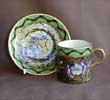
Maling historyThe 1920s - Lucien Boullemier, Maling's great designerNo doubt the 'black ground' wares appealed to post-Victorian tastes. A decade or so later, people were looking for something more 'jazzy'. Maling obliged with bright, bold primary colours, set off by elegant and understated borders. These, and a range of delicate, pale oriental designs, are the creation of designer Charles Wright, who stayed at Maling only a few years before joining the Keeling factory to take charge of their well-known 'Losol' ware. The resemblance between his 'Losol' wares and his earlier work for Maling is unmissable (see left-hand pic). However, the high point of the 1920s for Maling was the acquisition in 1926 of Lucien E Boullemier as designer. Mr Boullemier brought a new panache to the factory and was prolific in his use of lustrous colours, lavish gilding and rich enamelling. Maling lustre wares from these times can easily stand comparison with that of more famous factories such as Wegwood. Mr Boullemier also favoured 'waved' designs - pieces whose background was made up of short, circular brush strokes (often, erroneously, referred to as Maling 'thumbprint' - as though the paintress had dipped her thumb in paint and smeared it over the piece in small circles.) It was, in fact, a skilled technique, as the former paintresses have always been at pains to point out. 'Waved' designs would continue to be a staple of Maling's output for several decades (as proved by the photograph on page 12).
|

